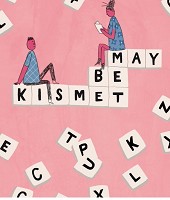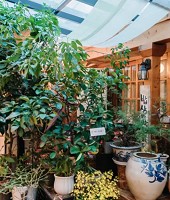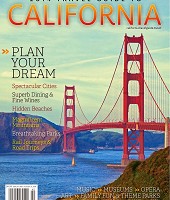
The Guardian UK: Top 10 historic sights in San Francisco
by Lavinia Spalding (google+)San Francisco has iconic landmarks aplenty: the Golden Gate bridge, Fisherman's Wharf, Alcatraz … and fog. But dig deeper and you'll find a richer history beyond the famous tourist sights
Fort Point
At the foot of the Golden Gate bridge is Fort Point, built from 1853 to 1861 to protect the Bay from naval attacks. It is constructed in the multi-tiered military style, with a design allowing cannons to hit enemy ships at water level; Fort Point is the only one of its kind in the west. Though never used in battle, the national historic site is an example of impressive masonry. Stop for coffee at The Warming Hut (built in 1909 as a US Engineer Storehouse), then make your way across that beautiful big red bridge – and don't forget a jacket! •
+ 1 415 556 1693, nps.gov/fopo.
Open Fri-Sun 10am-5pm, admission free
Mission Dolores and The Mission District
Spanish missionaries settled Yerba Buena (later renamed San Francisco) on 29 June 1776, five days before the Declaration of Independence was signed. Visit the spot where it all began: Mission Dolores, the city's oldest intact building, and one of only two cemeteries remaining in the city. The neighborhood, originally populated by the people, is a vibrant Latino arts community – don't miss the Clarion Alley and Balmy Alley murals – and a foodie paradise. But no visit to San Francisco is complete until you've patronised a taquería (taco shop) and tasted your first Mission burrito. • Mission Dolores, 3321 16th Street, +1 415 621 8203, missiondolores.org. Open daily (except
holidays) 1 May-31 Oct, 9am-4.30pm and 1 Nov-30 Apr, 9am-4pm, admission free
The Old Ship Saloon
When California struck gold, some 300,000 fortune hunters stormed the state, many traveling by sea and abandoning their boats. The Old Ship Saloon is built on the remains of The Arkansas, which ran aground on Alcatraz in 1849. Two years after being towed in, an enterprising Englishman cut a hole in the hull and began serving spirits, and it's operated as a saloon, brothel, rooming house, or shanghai den ever since. The term "shanghaied" originates here: unlucky patrons downed drug-spiked liquor and woke up on a ship at sea. Today, this locals' hangout is fairly innocuous, but the Pisco Punch still packs a wallop. • The
Old Ship Saloon, 298 Pacific Avenue, oldshipsaloon.com.
Open Mon-Fri 11.30am-2am
Cable Car Museum
In 1869, during the American industrial age, Andrew Smith Hallidie witnessed a carriage accident that killed five horses. He decided something had to be done. Enter San Francisco's iconic transportation system. Before riding one of the three lines still in operation, visit the Cable Car Museum, where you can even watch the engines and winding wheels pulling the cables. Then hop aboard and regale fellow passengers with all you've learned about grips, tracks and brakes. A local's tip: instead of waiting in line, walk to the next stop and board en route, wherever you see the brown and white cable-car sign. • Cable Car Museum, 1201 Mason Street, cablecarmuseum.org. Open daily 1 Apr-30
Sept 10am-6pm and 1 Oct-31 March 10am-5pm, admission free
Cliff House and Sutro Baths
A daytime excursion to Cliff House is a must. Go for the panoramic ocean views, martinis, oysters, Crab Louie – and the
stories. Built in 1863, the Cliff House was levelled by fire twice, in 1894 and 1907 (just a year after surviving the great earthquake), and rebuilt and renovated again and again. While there, visit the Camera Obscura after Leonardo da Vinci's 15th-century design), and explore the ruins of the colossal Sutro Baths, which once accommodated up to 10,000 swimmers. • The
Cliff House, 1090 Point Lobos Avenue, +1 415 386 3330, cliffhouse.com. Open for
lunch Mon-Sat 11.30am-3.30pm, Sun 11am-3.30pm, dinner, daily 5pm-9.30pm
The Fairmont Hotel
The 1906 earthquake was one of the worst natural disasters in American history, reducing much of San Francisco to rubble. But not the Fairmont, which "stood Parthenon-like at the top of the hill." Suffering only structural damage, the brand-new hotel opened one year later and has since hosted the first United Nations meeting, every president since William Howard Taft, and Tony Bennett, who crooned I Left My Heart in San Francisco there. Maybe you will, too, after a couple of Tonga Room Mai Tais. Not your style? Reserve afternoon tea service – with honey from the hotel's own beehives – in The Laurel Court. • The Fairmont, 950 Mason
Street, +1 415 772 5000, fairmont.com/san-francisco.
Tea service Sat-Sun 1.30pm-3.30pm
Angel Island
More tourists visit Chinatown annually than the Golden Gate bridge, but you'll find the real story at Angel Island where, from 1910-1940, hundreds of thousands of Chinese immigrants were detained – sometimes for months or years. What is often referred to as the Ellis Island of the west was built after the 1882 Chinese Exclusion Act was passed, a response to xenophobia and resentment toward Gold Rush-era immigrants. Now it's a museum preserving the history, including 100-plus Chinese poems found etched into the walls. The hilly island also offers spectacular views, beaches, cycling and hiking trails, Segway tours, campsites, a cafe and a weekend oyster bar. • Angel Island, angelisland.com. Open daily April-October,
March Wed-Sun. Guided tours $7 adults, $5 kids. Self-guided tours also
available. Round-trip ferry ticket from San Francisco $17 adult
City Lights Bookstore
Nothing symbolises the 50s beat generation like this historic landmark and local gem, founded in 1953 in North Beach. City Lights gained national recognition when owner Lawrence Ferlinghetti was charged with obscenity for publishing Allen Ginsberg's Howl – and prevailed. When you're finished browsing the shop's three levels of books, bring your new acquisition across the street to Vesuvio and raise a glass to the ghosts of Jack Kerouac and Neal Cassady, who frequented the legendary watering hole. And while you're in Little Italy, stop for an afternoon espresso at Café Trieste, where Frances Ford Coppola reportedly wrote the Godfather screenplay. • City Lights, 261 Columbus Avenue, citylights.com. Open daily 10am-midnight.
Vesuvio, 255 Columbus Avenue, vesuvio.com.
Open daily 6am-2am
Haight Ashbury and Golden Gate park
If you missed the Summer of Love and your inner flower child wants out, head to the Upper Haight, where echoes of the bohemian counterculture that drew hundreds of thousands of hippies in the 1960s – shifting the nation's political climate forever – are inescapable. Nurse a pint at Magnolia Gastropub and Brewery, formerly Magnolia Thunderpussy (named for the burlesque performer who owned the restaurant in the 60s), which once offered an all-night delivery service and erotic desserts. Hit a head shop, buy some fringed velvet pants at a consignment shop, then cross the street into Golden Gate park, the site of the first "Human Be-In"". • Magnolia
Gastropub and Brewery, 1398 Haight Street, +1 415 864 7468, magnoliapub.com. Open Mon-Thurs
11am-midnight, Fri 11am-1am, Sat 10am-1am, Sun 10am-11pm
The Castro Theater and neighbourhood
The
Castro Theater is one of only a few American 1920s-era movie palaces still in operation. Plan your trip around a sing-along night (think Sound of Music, Little Mermaid, Grease) and arrive early to catch the live Wurlitzer organ performance. Then, visit the sidewalk plaque outside the former site of Harvey Milk's camera store and campaign centre, the hub of the gay community in the 70s. Finally, have a nightcap at Twin Peaks Tavern, a historic landmark believed to be the nation's first gay bar with full-length, plate-glass windows, which allowed patrons to see out and the public to see in. • Castro Theater, 429 Castro Street, +1
415 621 6120, castrotheater.com. Twin
Peaks Tavern, 401 Castro Street,, twinpeakstavern.com.
Open daily midday-2am
Going: New Orleans, The Southern US City Where Jazz Was Born
Parents: I Grew Up in a Haunted House—Here’s What I Tell My Child About Ghosts
AFAR: Seoul Food
Off Assignment, Letter to a Stranger: “To the Shopkeeper in Fez”
The Bold Italic: “Working Three Jobs Nearly Killed Me”
AirBnB Magazine: “So I Slept in a ...Cave”
AAA Westways Magazine: “Korean Encore”
AFAR.com: “Everything You Need to Know About Jazz Fest”
AFAR.com: “Get Beyond the Beads: The 101 on Mardi Gras Throws”
AFAR.com: “The Art of Eating Crawfish in New Orleans”
AFAR.com: “Find New Orleans’s Soul at These 6 Mini-Museums”
Ms. Magazine: “Politics is on the Menu at Hell’s Backbone Grill”
AirBnB Magazine: “New Orleans for the Celebratory”
Off Assignment, Letter to a Stranger: “To the one who was supposed to get away”
Off Assignment, Letter to a Stranger: “To Old Johnny”
Viator: “Coming Full Circle”
World Hum: “How Korean Karaoke Changed my Life”
Independent Bookstore Day’s anthology: “My Lesson from Hell”
-
The New York Times, Modern Love: “Goodbye, My Fantasy Man”
I wasn’t willing to settle for less than kismet. But chasing a romantic illusion nearly kept me from finding love. -- The night I agreed to try online dating, I told my roommate Meghan I hoped I wouldn’t meet anyone because that wasn’t the kind of story . . .
-
River Teeth: A lot of Tomorrows
We are at the dinner table when my young son asks, “The day after a lot of tomorrows, will we build a treehouse?” I want to scoop him in my arms, this boy so eager and fresh, so tall his forehead meets my shoulder. If I could, I would lift his body above . . .
-
AFAR: Seoul Food
I still clearly remember my first meal in South Korea. I had just arrived in the country, fresh out of college and ready to begin a job teaching English. My new boss had whisked me from the airport to a barbecue restaurant, where I’d watched in panic as . . .
-
The New R&R
. . .





























